Will the Velocity of Money Save the U.S. Economy?
Economics / Money Supply Jan 25, 2010 - 09:57 AM GMTBy: Paul_L_Kasriel
 Before we get started, let's get the forecast update out of the way. With the release of November business inventories data, we have revised up significantly our real GDP annualized growth rate for Q4:2009 - from last month's projection of 3.5% to 4.5%. Again, it is a sharp slowing in the rate of inventory liquidation that is driving this upward revision. Our projection of the annualized growth rate for final sales in Q4:2009 is 1.6%, just one tick above Q3's reported growth. So, the anticipated surge in top-line fourth-quarter growth is largely an inventory story. Unless, however, final demand begins to grow faster, the inventory story of the last year's fourth quarter will be a one-off event.
Before we get started, let's get the forecast update out of the way. With the release of November business inventories data, we have revised up significantly our real GDP annualized growth rate for Q4:2009 - from last month's projection of 3.5% to 4.5%. Again, it is a sharp slowing in the rate of inventory liquidation that is driving this upward revision. Our projection of the annualized growth rate for final sales in Q4:2009 is 1.6%, just one tick above Q3's reported growth. So, the anticipated surge in top-line fourth-quarter growth is largely an inventory story. Unless, however, final demand begins to grow faster, the inventory story of the last year's fourth quarter will be a one-off event.
And this is where the "M" and the "V" referenced in this month's commentary come into play. After surging right after Lehman's failure in September 2008, growth in the M2 money supply (predominantly physical currency, checkable deposits, saving deposits, small time deposits and household money market mutual fund shares) has been trending lower. As shown in Chart 1, in the 6 months and 12 months ended December 2009, the annualized growth in M2 was 1.9% and 3.4%, respectively. In the past 20 years, only the early 1990s experienced similarly weak M2 growth for any length of time (see Chart 2).
Chart 1
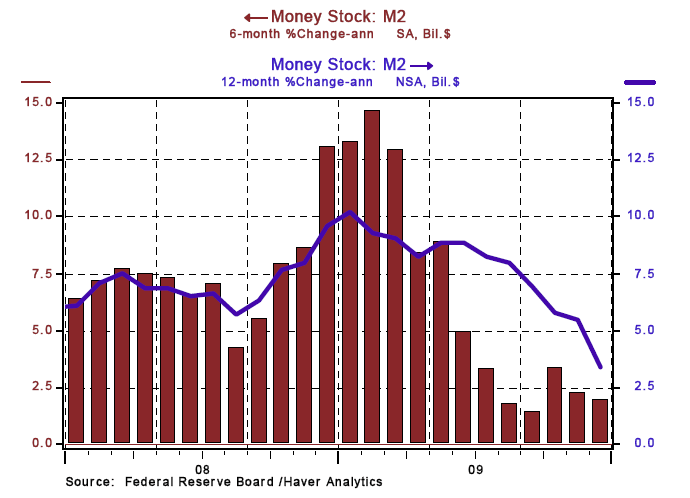
Chart 2
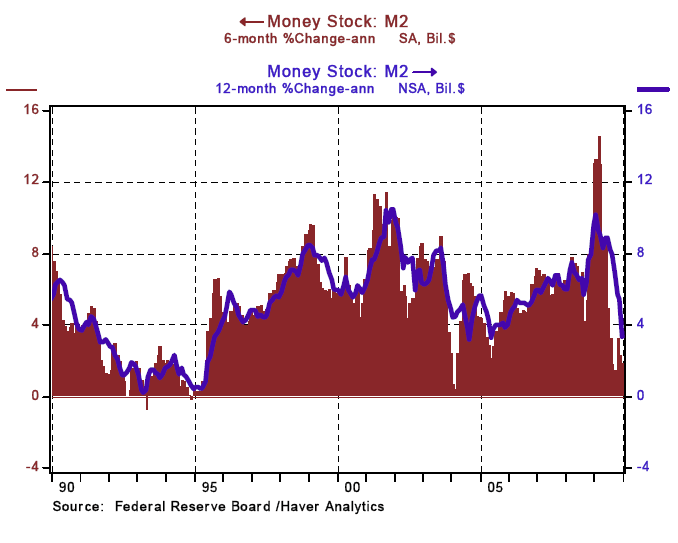
It is no coincidence that there is a similarity between the early 1990s and the current period in terms of weak money supply growth. In the early 1990s, the aggregate credit creation of commercial banks, S&Ls and money market mutual funds was relatively low, albeit not as low as it has been in recent quarters (see Chart 3). The reasons for the relatively low amounts of credit creation in both periods are the same - failures of many financial institutions and capital constraints on many of the surviving institutions. If depository financial institutions are not creating much credit, which appears as assets on their balance sheets, then it is a good bet that their liabilities will not be increasing by much either. The M2 money supply is made up primarily of the deposit liabilities of depository institutions and the shares of money market mutual funds, with a little "folding money" thrown in.
Chart 3
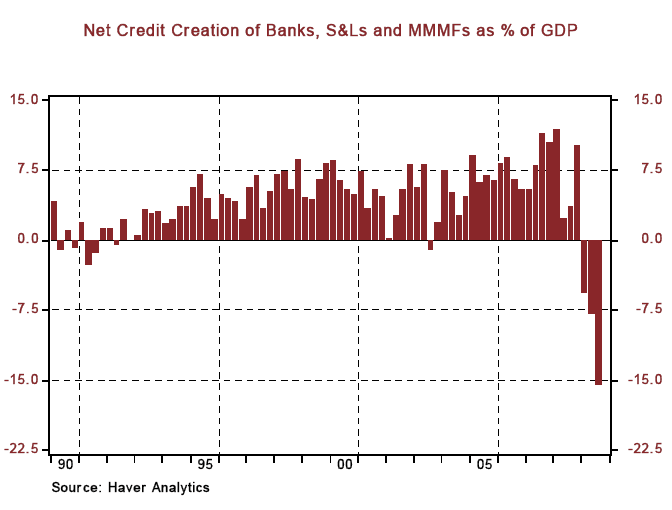
There is a famous monetary identity: M*V = nominal value of transactions. "M" is some measure of the money supply. As discussed above, growth in the M2 measure of the money supply has been quite weak in recent months. "V" represents the velocity, or turnover, of that particular measure of the money supply. The more money people want to hold rather than turnover in transactions, the lower is V. Re-arranging terms in the identity, we get: V = nominal value of transactions / M. All else the same, if M is declining or growing slowly, the nominal value of transactions will follow suit. But an increase in V can offset a decline in M. This is what we want to investigate. If money supply growth remains weak because of an inability of depository institutions to create credit due to capital constraints, will the velocity of money increase enough to allow faster growth in the value of nominal transactions?
Just as different definitions of the money supply can be used in the monetary identity, different definitions of the value of transactions can be used. Typically, nominal GDP is used. In this exercise, we choose to use the value of nominal retail sales. Shown in Chart 4 is the behavior of velocity (nominal retail sales / M2) on a quarterly average basis over the past 20 years. Velocity fell off a cliff at the end of 2008 and hit a 20-year low in the second quarter of 2009. As mentioned above, the early 1990s also were a period of exceptionally weak M2 money supply growth. But, as shown in Chart 4, providing a partial offset to the weak M2 money supply growth at that time was a rise in the velocity of that M2 money supply. Fast forwarding to today, M2 velocity has come off its Q2:2009 trough. But what is critical in determining the strength of the 2010 economic recovery is how fast monetary velocity increases in 2010.
Chart 4
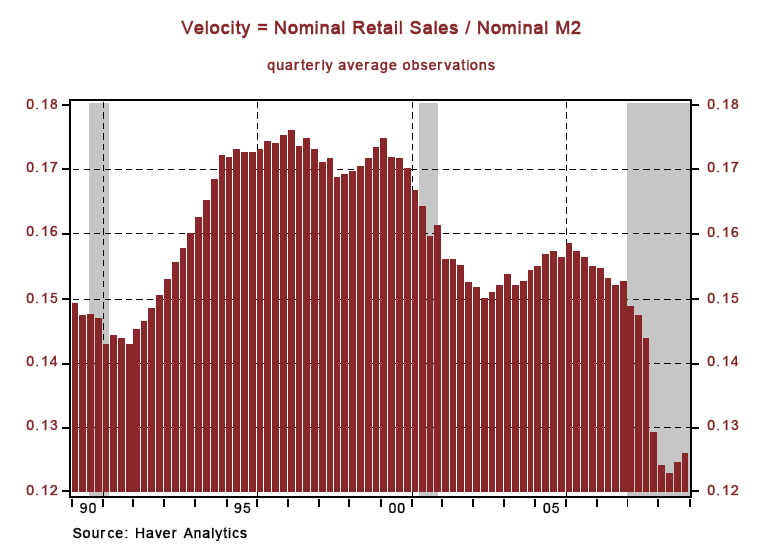
Shown in Chart 5 is the relationship between M2 velocity and the levels of short-term and long-term interest rates. In both the early 1990s and recently, periods in which M2 money supply growth was and is weak, short-term interest rates, a proxy for rates paid on bank interest-bearing deposits and money market funds, fell substantially - both in absolute terms and relative to yield levels on longer-term securities. In the early 1990s, this absolute and relative decline in short-term interest rates was followed by a significant increase in M2 velocity. The considerably higher returns available on non-deposit assets induced households to reduce the amount of bank deposits they desired to hold. So, the very slow rate of growth in the M2 money supply was offset be a decline in the demand to hold M2.
Chart 5
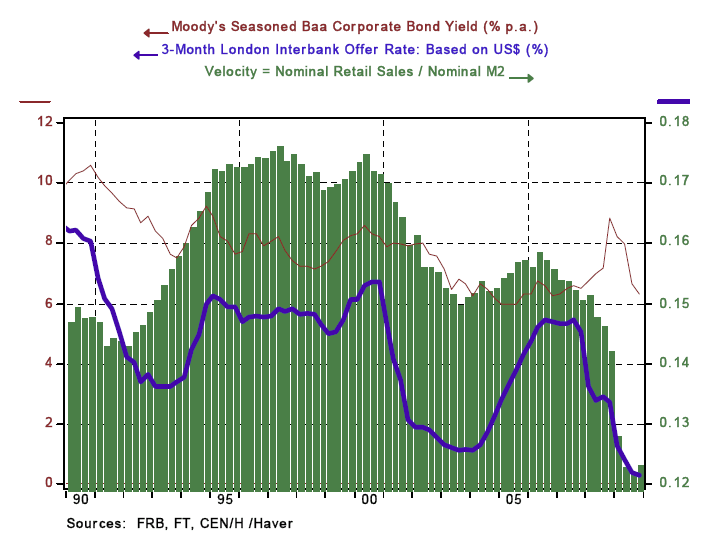
So, should we expect a similar surge in M2 velocity in 2010 as was experienced in the early 1990s? Perhaps not. This past economic recession and financial crisis resulted in the largest household capital losses, excluding real estate, in the post-war era (see Chart 6). By an order of magnitude, the recent losses surpassed those experienced in 1990. Including real estate, the recent capital losses were even more severe. Moreover, the capital losses experienced in the past several years occurred across a wide spectrum of asset classes. It would be reasonable to expect that household investors today are more risk averse than they were in the early 1990s.
Chart 6
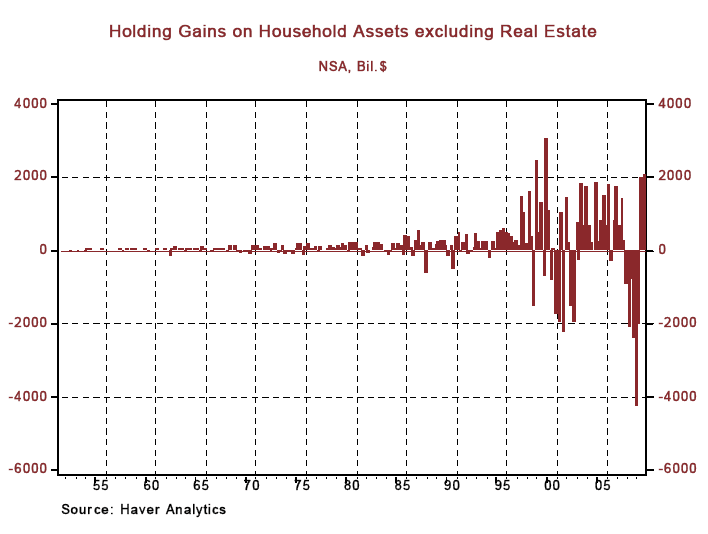
A proxy for risk aversion would be the differential between the yield on a lower-rated investment grade corporate bond and the yield on a Treasury bond, which has no default risk. The behavior of this yield differential is shown in Chart 7. Notice that although this yield differential has narrowed considerably from its extreme in the fourth quarter of 2008, it remains well above the differentials that obtained in the early 1990s. This is consistent with higher household investor risk aversion today as compared with the early 1990s. Greater investor risk aversion implies that investors are more willing to accept lower yields on federally-insured bank deposits than otherwise.
Chart 7
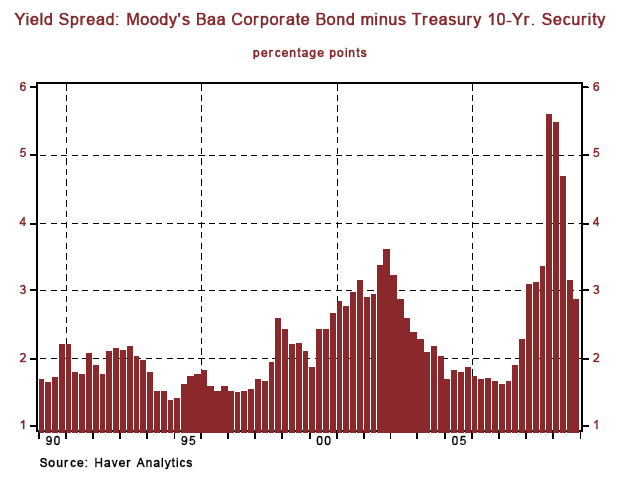
To summarize, M2 growth currently is extremely weak. It likely will remain relatively weak through 2010 as credit creation by depository institutions will be impeded by capital constraints. If investors remain risk averse, their demand to hold federally-insured bank deposits will remain relatively high. This implies that velocity of the M2 money supply will not increase rapidly. Weak M2 money supply growth in combination with weak M2 velocity growth implies a sluggish economic recovery in 2010.
Paul Kasriel is the recipient of the 2006 Lawrence R. Klein Award for Blue Chip Forecasting Accuracy
by Paul Kasriel and Asha Bangalore
The Northern Trust Company
Economic Research Department - Daily Global Commentary
Copyright © 2010 Paul Kasriel
Paul joined the economic research unit of The Northern Trust Company in 1986 as Vice President and Economist, being named Senior Vice President and Director of Economic Research in 2000. His economic and interest rate forecasts are used both internally and by clients. The accuracy of the Economic Research Department's forecasts has consistently been highly-ranked in the Blue Chip survey of about 50 forecasters over the years. To that point, Paul received the prestigious 2006 Lawrence R. Klein Award for having the most accurate economic forecast among the Blue Chip survey participants for the years 2002 through 2005.
The opinions expressed herein are those of the author and do not necessarily represent the views of The Northern Trust Company. The Northern Trust Company does not warrant the accuracy or completeness of information contained herein, such information is subject to change and is not intended to influence your investment decisions.
Paul L. Kasriel Archive |
© 2005-2022 http://www.MarketOracle.co.uk - The Market Oracle is a FREE Daily Financial Markets Analysis & Forecasting online publication.



